Lovely Burghausen Castle
I love castles, especially the medieval kind. As a result, I visit castles pretty much whenever I can. So this summer, as we were on our way to a vacation in Romania, we decided to make a stop at Burghausen Castle. I’d never heard of the place, but it was marked as a castle on our old-fashioned paper map. A quick Wikipedia check showed that it was pretty.
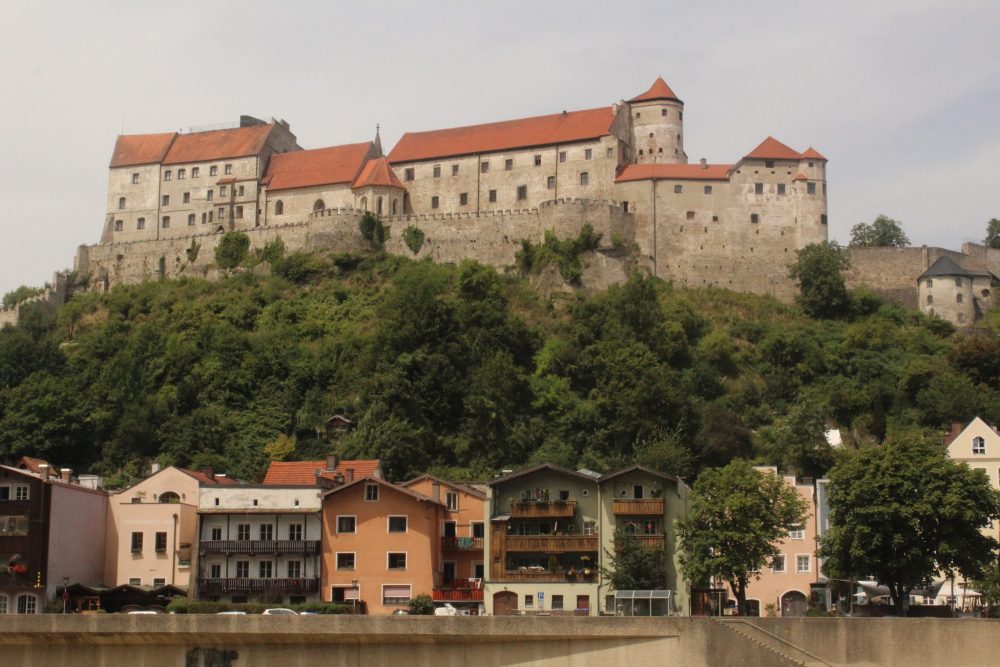
It’s more than pretty. I think Burghausen may rank among the prettiest medieval castles I’ve ever been to.
Disclosure: This article contains affiliate links. Making a purchase through one of these links will earn a commission for this website. This will not affect your price.
Burghausen Castle’s history
The building of Burghausen Castle started in 1255, ordered by Duke Henry XIII of Lower Bavaria. Over the next two centuries, the Dukes of Bavaria-Landshut expanded it and extended the fortifications around the whole hill. Duke Henry XVI sent his wife to stay there, something that continued under his son and grandson, so that the castle became, essentially, a home for widows and rejected wives and consorts.
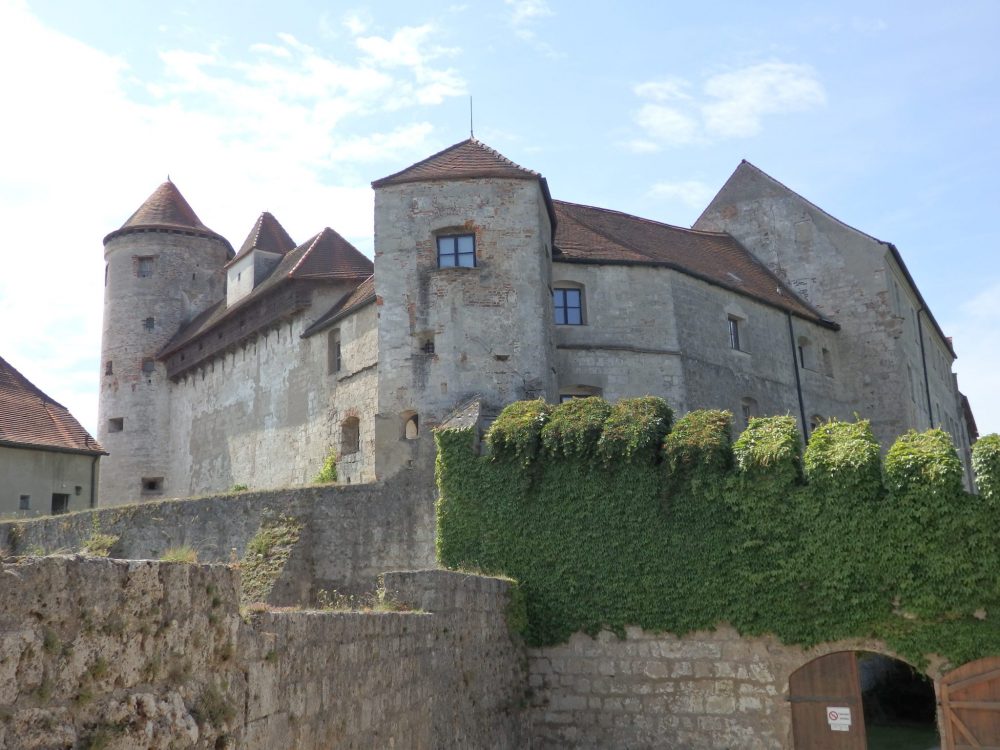
In the 1500s, with the ongoing threat from the Ottoman Empire, the castle was strengthened and fortified further up until the 18th century. In 1779 it became a border castle with Austria. Later, in the 1800s, the outer walls were torn down by the French and it generally lost its usefulness for defense under Napoleon.
Several renovations in the 19th and 20th century, along with partial privatization of parts of the castle, and what we see today is simply charming.
Think about staying in accommodations in Burghausen so you can enjoy both the castle and the pretty town at your leisure.
Burghausen Castle today
Arranged along the ridge of a hill, Burghausen is the longest castle in the world, at just over a kilometer long from end to end. It includes five courtyards in a row (six by some counts). On one side it overlooks the Salzach River, which is the border with Austria. On the other side is a lake called the Wöhrsee, which used to be a branch of the river.
The fifth courtyard
The fifth courtyard is where you first enter. At this point, it looks like a picturesque old street with a clock tower in the middle and a couple of interesting older buildings. We didn’t actually realize at this point that we’d entered the castle. Originally, a fortified building stood here, closing off the castle complex.
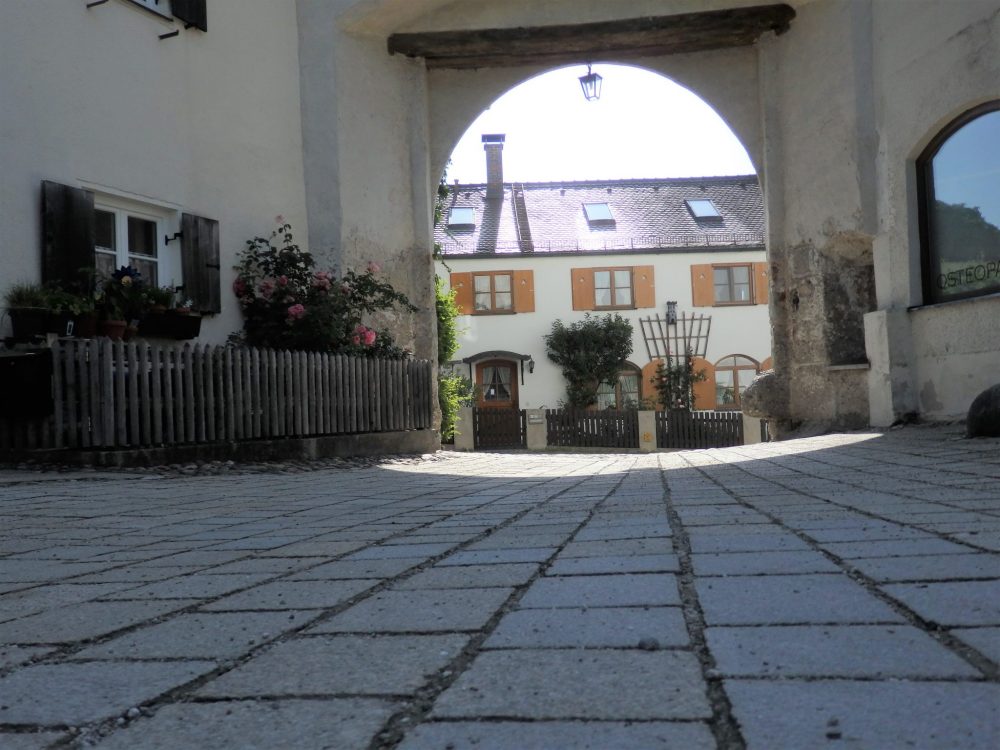
Several of the buildings around this courtyard look like they are private homes. Imagine living in a castle!
You can visit an art gallery or a photography gallery in the fifth courtyard. We didn’t, since we were focused on seeing the castle.
The fourth courtyard
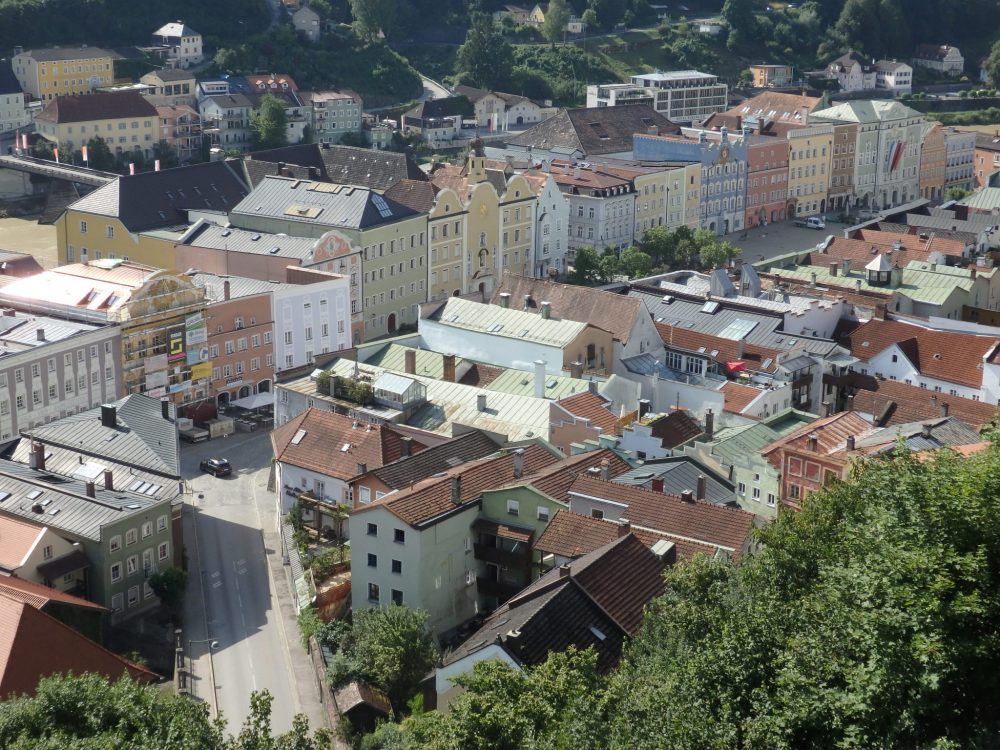
Here it begins to look like a castle in that there are old stone walls around this courtyard and a very picturesque gate with towers straight ahead. Peering over the walls, you can see the Wöhrsee on one side and the town of Berghausen on the other (also worth a visit, but I’ll get to that later.)
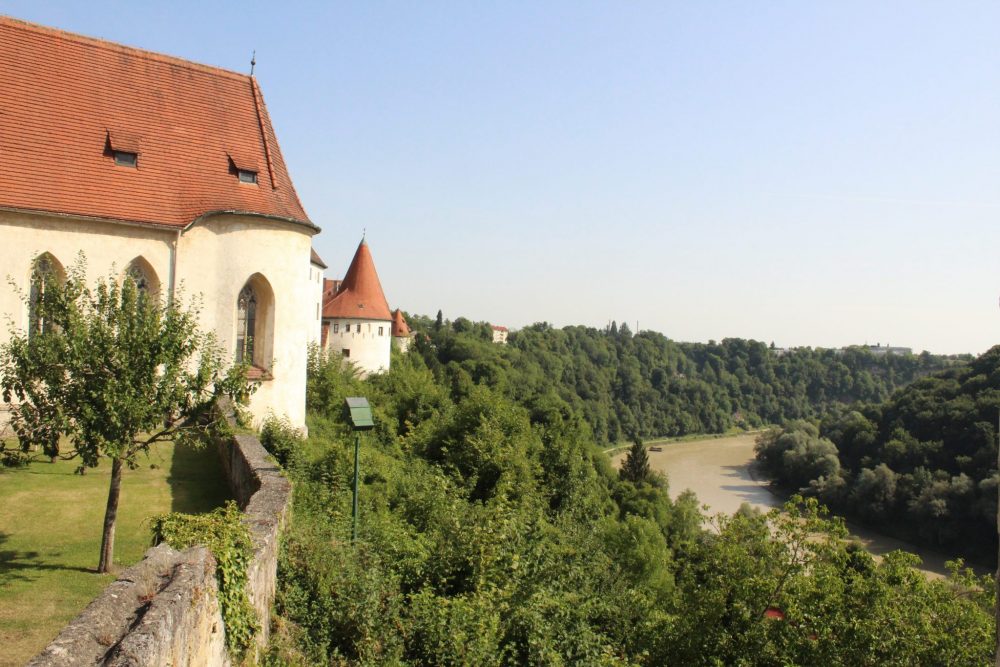
The main attraction here is a little late Gothic church called Hedwig’s Chapel (1479-1489). Duke George the Rich of Bavaria built it for his wife, Hedwig, daughter of King Kasimir IV of Poland. You can see it in the pinnable image at the bottom of this post.
If you’re traveling with a family or group, it might be worthwhile to hire a private guide.
The third courtyard
This courtyard is long and narrow. Unfortunately for us, the most interesting building in this courtyard, called Aventinus House, was hidden by scaffolding when we visited. It has a stepped gable and was also built in the 1400s.
The long simple building opposite is a reconstruction of a stable building that used to stand in the same place.
The second courtyard
Walking through another large gateway, we entered the smaller second courtyard, dominated by a large, plain, rather grim, rough stone building with barred windows. It was called the Kurzer Kasten and dates from 1427. Originally it was an armory, with grain storage on the upper floors.
Opposite this building is a row of watchtowers. An opening in the wall leads to a small, lower, side courtyard and a path down to the town square below. From here we again had some spectacular views.
The first courtyard
From the second courtyard, we approached George’s Gate, crossing a bridge over a moat. It’s a permanent bridge now, but once upon a time it would have been a drawbridge.
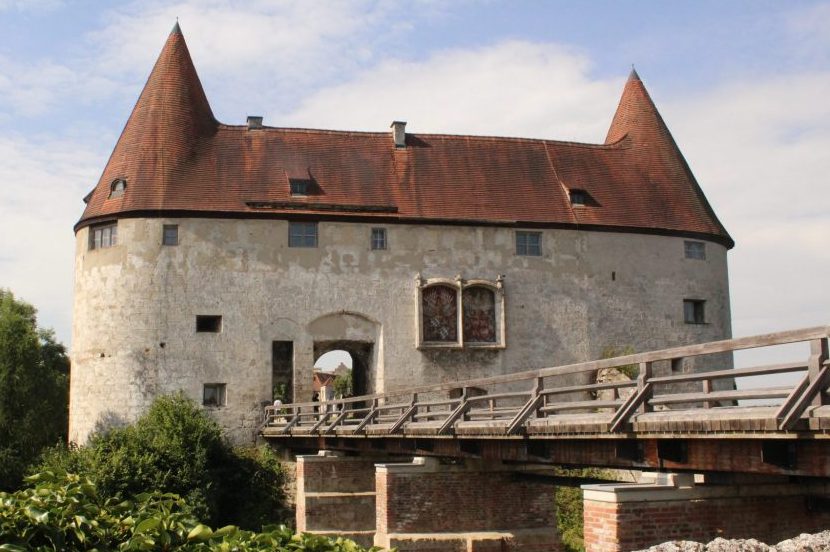
The gate is more or less original and dates from 1494. The large coats of arms to the right of the doorway mark the marriage of Duke George the Rich (Bavarian coat of arms) to Hedwig of Poland (Polish coat of arms) in 1475.
This courtyard beyond the gate is also quite narrow and long, edged with high walls. The castle café is here, housed, appropriately, in what was originally the castle brewery. We saw more splendid views, and a stairway, once fortified, leads down to the town.
While I was at Burghausen Castle, I did several Facebook live videos. Most of them came out too pixelated to be much use, but this one is a bit better. It shows from the 2nd courtyard into the castle courtyard. It’s a bit long, so I won’t be offended if you skip around!
The castle courtyard
Another imposing gate guards the entrance to the castle itself, again including what was once a drawbridge over a moat. This one is the highlight: an absolutely classic just-as-you-pictured-it castle courtyard. It’s not large, and it’s irregularly shaped, and I could imagine riders on horses clopping into it on the cobblestones, hurrying to deliver important messages, servants scrubbing clothing in tubs or carrying wood or doing any of the various chores that would have supported such an establishment.
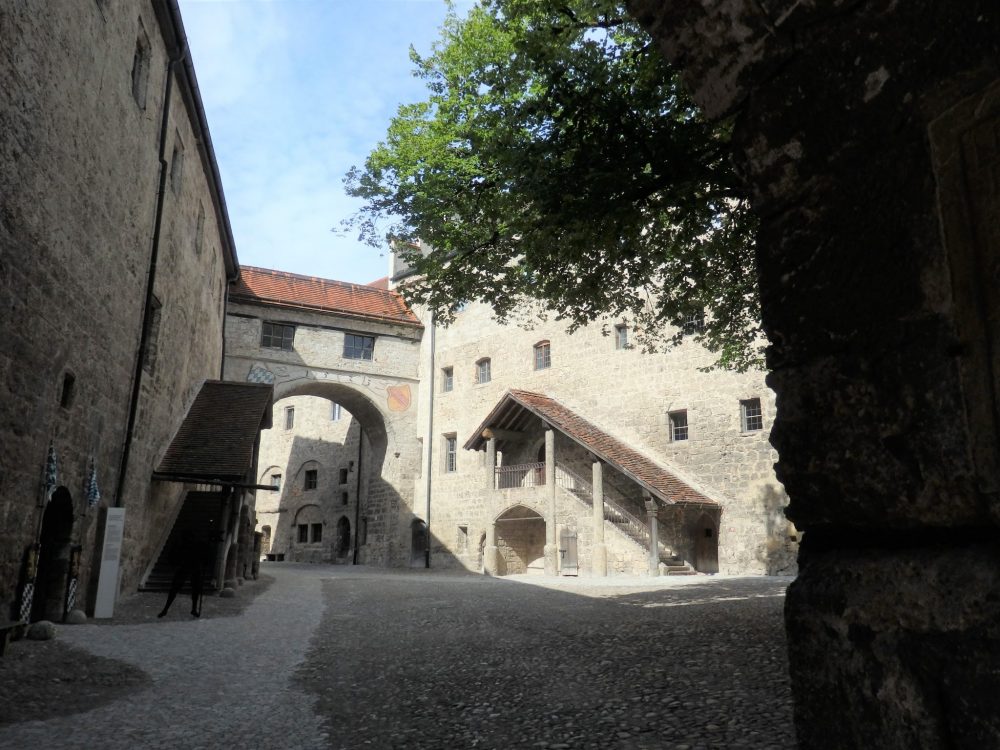
Like any self-respecting castle, this one has a tall castle keep, a portcullis (well, the slot for one anyway), a dining room and ballroom, residences for a royal family, a chapel, a dungeon, and a treasure chamber. Many of these spaces are now used for a museum. Most of the buildings here date to the 15th century, though some are older. The Gothic-style Elisabeth chapel, for example, was built in 1255 and modified in the 15th century.
In the museum, you can take the stairway up onto the roof for 360-degree views: along the river, down over the town, and back along the kilometer-long castle.
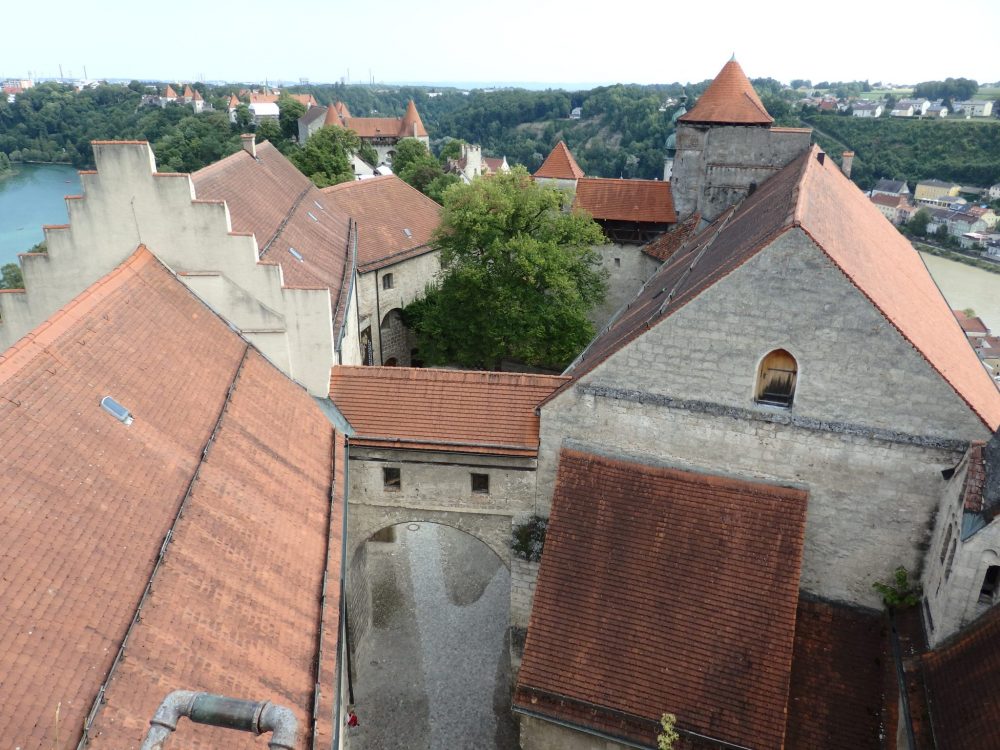
The town of Burghausen
We had briefly driven through the town of Burghausen on the way to Burghausen Castle and decided to go take a closer look. The old center extends along the river, and while it had been there for many centuries, it was at its height in the 15th and 16th centuries. The dominant industry was trading in salt from Heilein, a salt mine near Salzberg in Austria. However, that ended when the Dukes established their own salt monopoly at the end of the 1500s and the town declined after that.
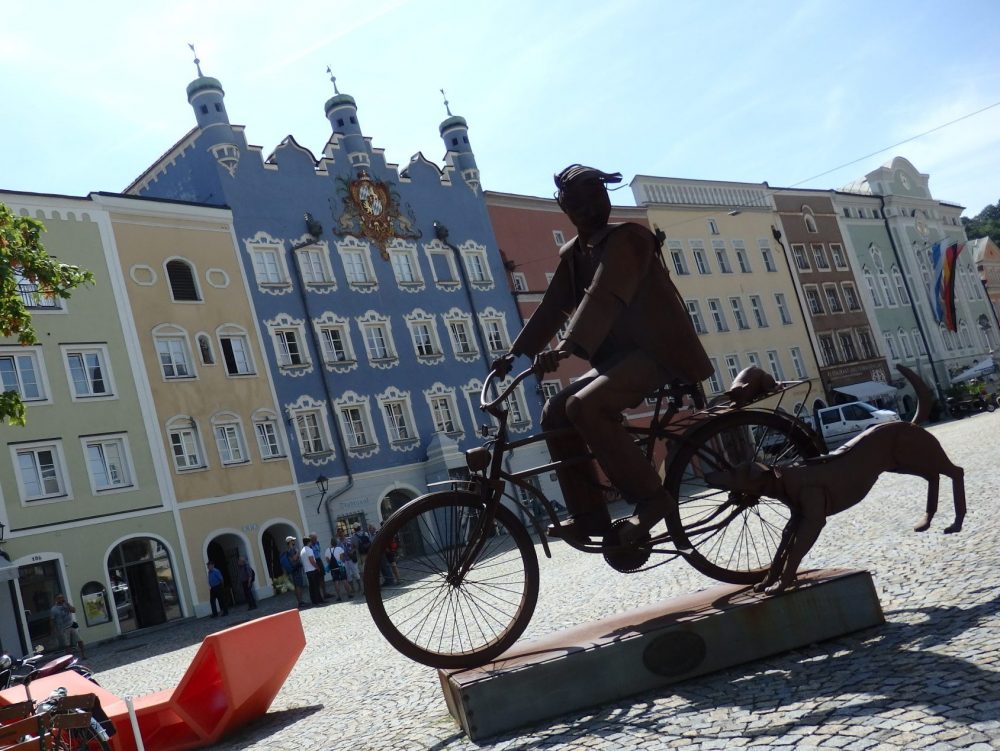
The town saw its rebirth when a chemical company, Wacker, opened production plants in Burghausen in the early 20th century. Today, you can see the results of its prosperity in its charmingly restored town center. I particularly liked how these lovely old buildings have been painted: mostly in pastels, with the ornamentation along the roof, windows and doorways in white.
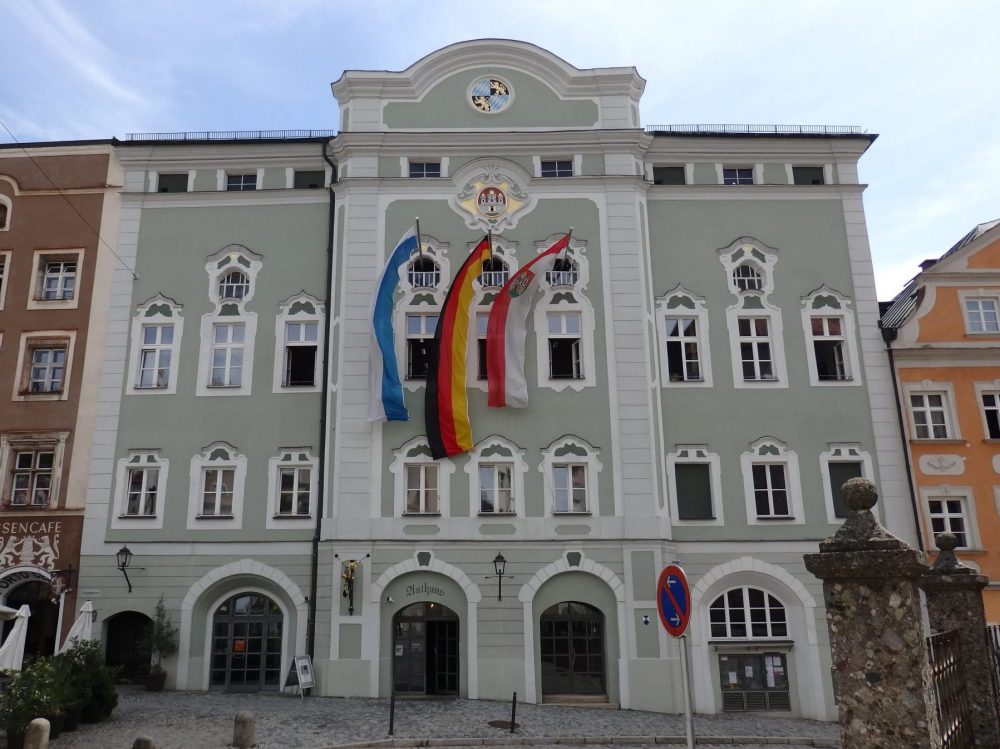
Visit Burghausen Castle
Most foreign visitors head for the castles along the Rhine River in Germany, or they go to Neuschwanstein, the castle that inspired Disney. Definitely go see them, but I don’t see why Burghausen isn’t on that must-see list. It’s among the best I’ve ever seen.
Burghausen Castle: Burghausen, Germany. Parking available nearby. Train to Burghausen station and then take a city bus to the castle. Museum open daily April-September 9:00-18:00; October-March 10:00-16:00. The grounds are always open. Admission: €5, children under 18 free. Website./
Updated October 13, 2024.
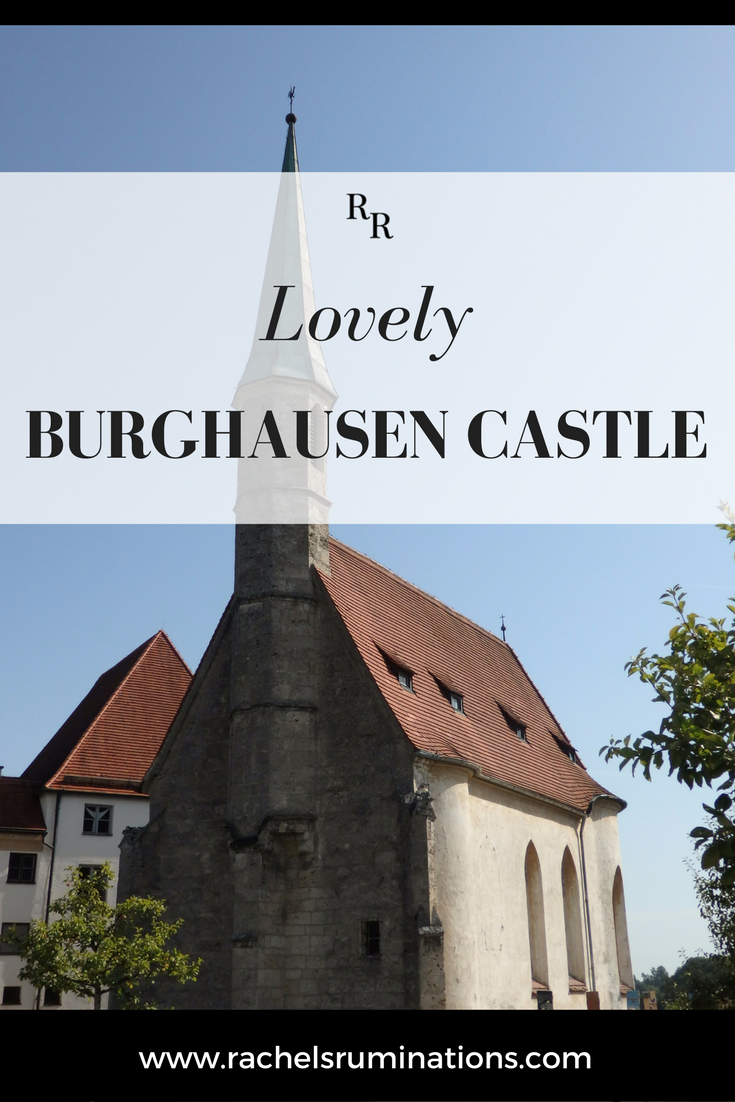
My travel recommendations
Planning travel
- Skyscanner is where I always start my flight searches.
- Booking.com is the company I use most for finding accommodations. If you prefer, Expedia offers more or less the same.
- Discover Cars offers an easy way to compare prices from all of the major car-rental companies in one place.
- Use Viator or GetYourGuide to find walking tours, day tours, airport pickups, city cards, tickets and whatever else you need at your destination.
- Bookmundi is great when you’re looking for a longer tour of a few days to a few weeks, private or with a group, pretty much anywhere in the world. Lots of different tour companies list their tours here, so you can comparison shop.
- GetTransfer is the place to book your airport-to-hotel transfers (and vice-versa). It’s so reassuring to have this all set up and paid for ahead of time, rather than having to make decisions after a long, tiring flight!
- Buy a GoCity Pass when you’re planning to do a lot of sightseeing on a city trip. It can save you a lot on admissions to museums and other attractions in big cities like New York and Amsterdam.
Other travel-related items
- It’s really awkward to have to rely on WIFI when you travel overseas. I’ve tried several e-sim cards, and GigSky’s e-sim was the one that was easiest to activate and use. You buy it through their app and activate it when you need it. Use the code RACHEL10 to get a 10% discount!
- Another option I just recently tried for the first time is a portable wifi modem by WifiCandy. It supports up to 8 devices and you just carry it along in your pocket or bag! If you’re traveling with a family or group, it might end up cheaper to use than an e-sim. Use the code RACHELSRUMINATIONS for a 10% discount.
- I’m a fan of SCOTTeVEST’s jackets and vests because when I wear one, I don’t have to carry a handbag. I feel like all my stuff is safer when I travel because it’s in inside pockets close to my body.
- I use ExpressVPN on my phone and laptop when I travel. It keeps me safe from hackers when I use public or hotel wifi.


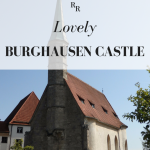
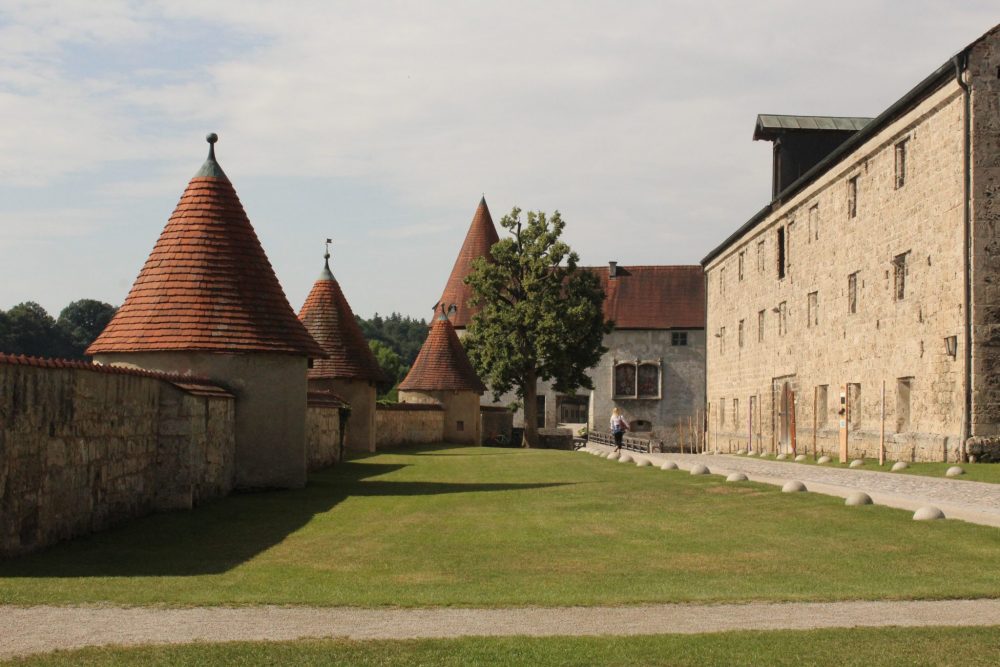

Oh I love castles too. I haven’t visited Burghausen Castle, although I have done a little travelling along the Rhine and oggled a few more beautiful Medieval castles.
Yes, the ones along the Rhine are beautiful too, but it just surprised me that this one is also beautiful and yet practically ignored!
I have to second your “I love castles” Rachel, from their ramparts to their cellars and dungeons! The video helped me appreciated how truly massive the castle is and the commanding view it had. And old town Burghausen, with its variety of colorful pastel painted buildings, was charming. Definitely a find and another add to my ever-growing, must-see list!
Actually, it’s longer than any of my pictures could show. Without a drone or a hot-air balloon I just couldn’t get a picture of the whole thing!
Five courtyards! That is quite the castle! I would love to visit Burghausen some day.
I love castles too! Especially ones I can spend the night in.
Will add Burghausen Castle to my personal to-do list for day tours.
This castle is so picturesque and remarkable. I have learned so much about it from your post, Rachel. Is a day trip enough to explore it?
I’m sorry it took me so long to answer this. It landed in my spam folder! Yes, a day trip is enough, even if you stop and explore the museum in more detail than we did. It’s a kilometer long, but not actually that big in terms of inside space.